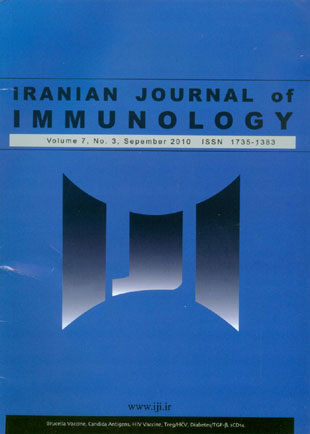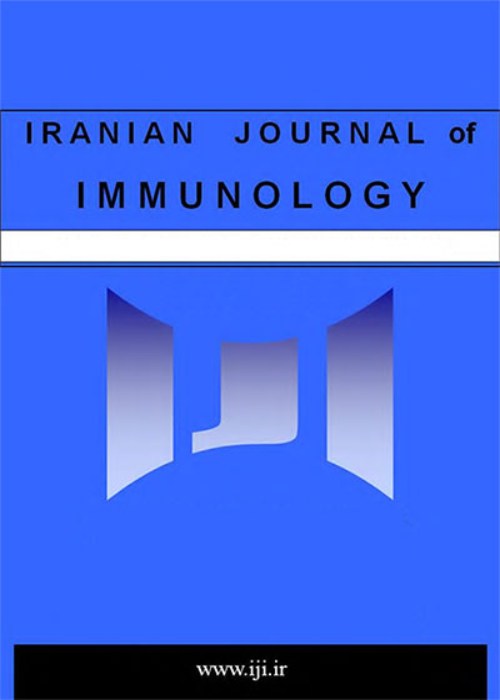فهرست مطالب

Iranian journal of immunology
Volume:7 Issue: 3, Summer 2010
- تاریخ انتشار: 1389/07/20
- تعداد عناوین: 9
-
-
Impact of Opium on the Serum Level of TGF-beta in Diabetic, Addicted and Addicted-Diabetic RatsPage 7BackgroundSeveral cells of immune system such as regulatory T cells andmacrophages secrete transforming growth factor-beta (TGF-beta) in response todifferent stimuli. This cytokine has inhibitory effect on immune system anddiminished production of this cytokine is associated with autoimmune disorders.ObjectiveThe aim of this study was to evaluate the influence of opium addiction on serum level of TGF-beta in male and female diabetic and non-diabetic Wistar rats.MethodsThis experimental study was performed on normal, opium addicted,diabetic and addicted-diabetic male and female rats. Serum level of TGF-beta wasmeasured by ELISA.ResultsThe results of our study indicated that the mean serum level of TGF-beta in female addicted rats was significantly increased compared to control group (p<0.004). Conversely, in male addicted rats the mean serum level of TGF-beta was lower compared with control (p<0.065).ConclusionOur results suggest that opium and its derivatives have differential inductive effects on the cytokine expression in male and female rats.
-
Detections of Autoantibodies against Gangliosides in Guillain-Barre SyndromePage 9
-
Page 132BackgroundBecause of high morbidity of the brucellosis in humans and the potential use of the microorganism as an agent of biologic warfare, protection of effective vaccines and specific diagnostic reagents become necessary to eradicate brucellosis.ObjectiveIn this study we aimed to investigate the cytokine responses and changes in peripheral blood lymphocyte subgroups of acute brucellosis patients in response to L7/L12 and glyceraldehyde 3-phosphate dehydrogenase (GAPDH) recombinant proteins derived from Brucella abortus.Methodslevels of IFN-γ, IL-4 and IL-10 secreted from PBMCs of 25 acute brucellosis patients and 15 healthy controls, stimulated with Phytohemagglutinin (PHA), L7/L12 or GAPDH were measured by ELISA. Furthermore alterations in lymphocyte subgroups in response to these Brucella antigens were determined by flow cytometry.ResultsExtracellular IFN-γ levels were found to be elevated after stimulation with L7/L12 in patients with acute brucellosis, whereas no significant changes were found in IL-4 and IL-10 levels. Similar data was also obtained with GAPDH, but the stimulation of IFN-γ production was not observed in all patients and was not as strong as that observed for L7/L12. Moreover, when the distribution of lymphocytes subgroups (CD3+, CD3+CD4+, CD3+CD8+, CD4+CD25+, CD3+CD69+ and CD3+CD152+) was evaluated, it wasfound that the stimulation with L7/L12 and GAPDH only led to an increase in thepercentage of CD3+CD69+ lymphocytes.ConclusionThese data indicate that Brucella abortus L7/L12 or GAPDH induce a Th1 type immune response in acute brucellosis patients. Additionally, these recombinant proteins, especially L7/L12, maybe used in new vaccine preparations and diagnostic tests.
-
Page 150BackgroundCerebral malaria (CM) is one of the major causes of death in Africanpopulations infected with Plasmodium falciparum. Only 1% of infected subjectsdevelop CM. The reasons for these differences are not fully understood, but it is likelythat the host humoral response against blood-stage antigens plays a role in protectionfrom malaria, although the precise targets and mechanisms mediating immunityremain unclear.ObjectiveThe purpose of this study was to distinguish betweendefined P. falciparum-specific Ab response patterns in patients presenting with mildmalaria (MM) vs. CM.MethodsWe used a panel of P. falciparum conserved antigens including crude blood-stage extracts schizont, merozoite and parasitised erythrocyte membranes and MSP-1p19, PfEB200, R23 and GST-5 recombinant antigens in a retrospective case-control study of symptomatic adults, one group presenting confirmed CM without fatal outcome and another group with MM. We further matched P. falciparum-specific Ab responses with those from individuals living in an endemic setting known to have protective immunity and considered them as “immune control” subjects (IC). Total IgG, IgM and IgG subclass Ab responses were determined using ELISA method.ResultsSubstantial Ab responses were foundin symptomatic patients, significantly lower than the “immune control” subjects, and with a limited quantitative difference between MM versus CM. Interestingly, asynchronous IgM response was evidenced in CM contrary to MM.ConclusionOur results suggest that the contribution of an efficient IgG response against parasite multiplication is of importance in the evolution towards CM manifestation without fatal outcome and deserves further analysis for vaccine candidates.
-
Page 162BackgroundNumerous evidences indicate that in some HIV-1 positive patients, the humoral and cellular immune responses are induced against HIV-1 proteins and this isinversely related to the progress of infection.ObjectiveThe aim of this study was the evaluation of the Adenovectors containing HIV genes in induction of immune responses in mice.MethodsThe HIV-1 genes including gag p24, rev, nef and exon-1 of tat were amplified from HIV-1 RNA (clade-A). The cDNA of each gene was cloned into a transfer vector. The transfer vector was then co-transformed into E. coli strain BJ5183 together with pAdenovector ΔE1/E3. The recombinant adenoviral construct was transfected into QBI-293A cells. Recombinant viruses were purified and titrated on 293 cell plates. Expression of transgenes was evaluated using westernblotting. Then 1012 viral particles were injected into 15 groups of 5 mice and all patterns of combination of these 4 HIV-1 genes were evaluated. After 2 weeks,humoral and cellular immune responses were evaluated using ELISA, cellproliferation and ELISpot (IL-2, IL-4 and IFN-γ) assays, consecutively.ResultsIt was demonstrated that each gene was expressed. The response targets were mostly toward Th1, though several Th2 responses were also observed. Single injection in our study induced a good cellular response but the humoral responses were not as strong as the cellular ones.ConclusionConsidering and comparing all results and evaluating the various possible interactions revealed that simultaneous injection of tat and gag has enhanced the humoral and cellular responses.
-
Page 177BackgroundRegulatory T cells (Tregs) have been involved in impaired immunityand may have a pivotal role in persistence of viral infections.ObjectiveTo develop a simple and reliable in-house three color flow cytometery of peripheral blood to understand the role of HCV infection in the increase of Tregs.MethodsThe level of naturally occurring CD4+CD25+FoxP3+ regulatory T cells (nTregs) in 20 chronically infected with hepatitis C virus (HCV) patients was compared to those of 15 healthy individuals by flowcytometry. In a different approach we performed permeabilization and intracellular staining before surface staining which allows the preservation of the surface molecules in the combined detection process and results in the normal frequency of nTregs in blood.ResultsUsing the optimized method, it was shown that a significantly higher proportion of nTregs in the total CD4+ T cell population was seen in the peripheral blood of chronic HCV patients (0.83 ± 0.21%, p=0.05) as compared to controls (0.26 ± 0.1, p=0.05).ConclusionsIn accordance with other studies, we showed that HCV infection induces a dramatic increase in Tregs, which might contribute to the immune response failure during HCV infection.
-
Page 193BackgroundEarly childhood caries (ECC) is a severe type of dental caries affecting infants and pre-school children. Because of the infectious nature of the disease, the immunologic response by the host plays an essential role in its development.ObjectiveThis study investigated the association between the presence of salivary sCD14 and ECC.MethodsThis study was carried out on 40 healthy children, of whom 20 were caries-free (CF) and 20 had ECC, within the ages of 36 to 71 months. Unstimulated saliva of the children was collected with disposable needle-less syringe from buccal and labial vestibules. Seven children with ECC received complete treatments. Saliva was collected for a second time after 3 months from this group. The sCD14 levels in salivary samples were analyzed by ELISA method.ResultsMean concentrations of sCD14 in ECC and CF groups were 57.82 and 31.92 ng/ml respectively (p=0.008). After three months, the mean concentration of sCD14 among the treated children decreased to 11.38 ng/ml, which was significantly lowercompared to that of ECC children before intervention (p<0.001), and also CF children(p<0.05).ConclusionThe increased levels of sCD14 can be considered as a markerof inflammation and innate immune response during ECC.


